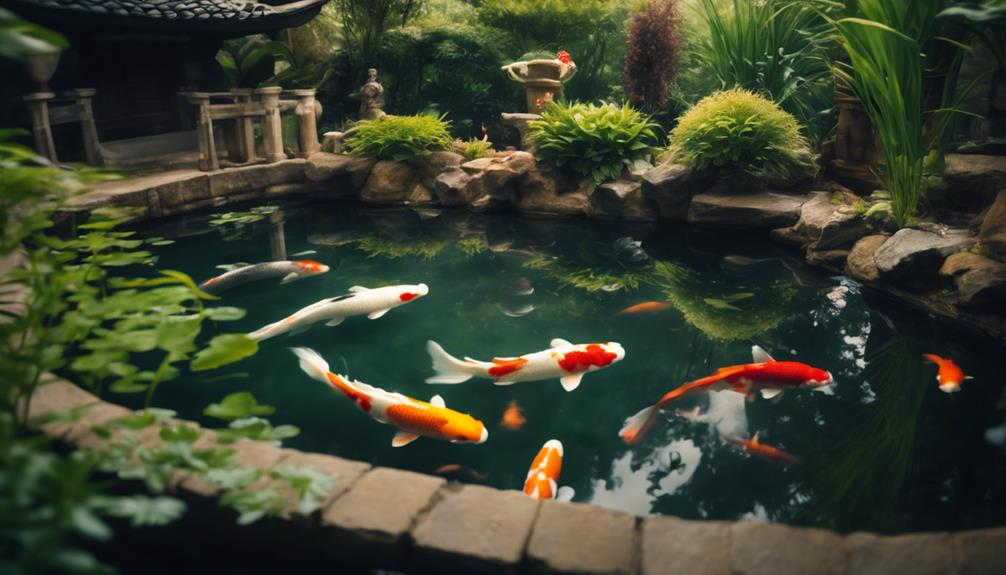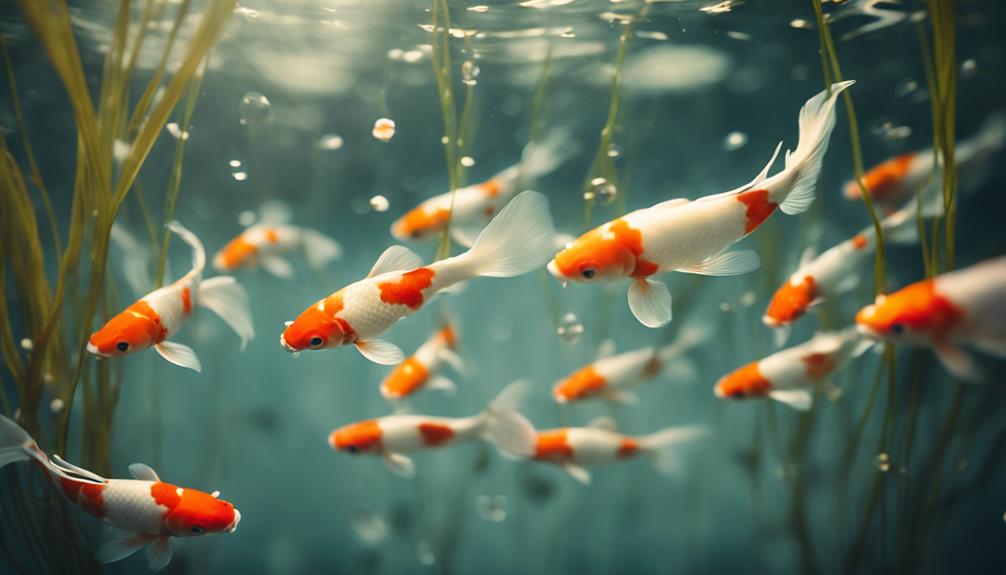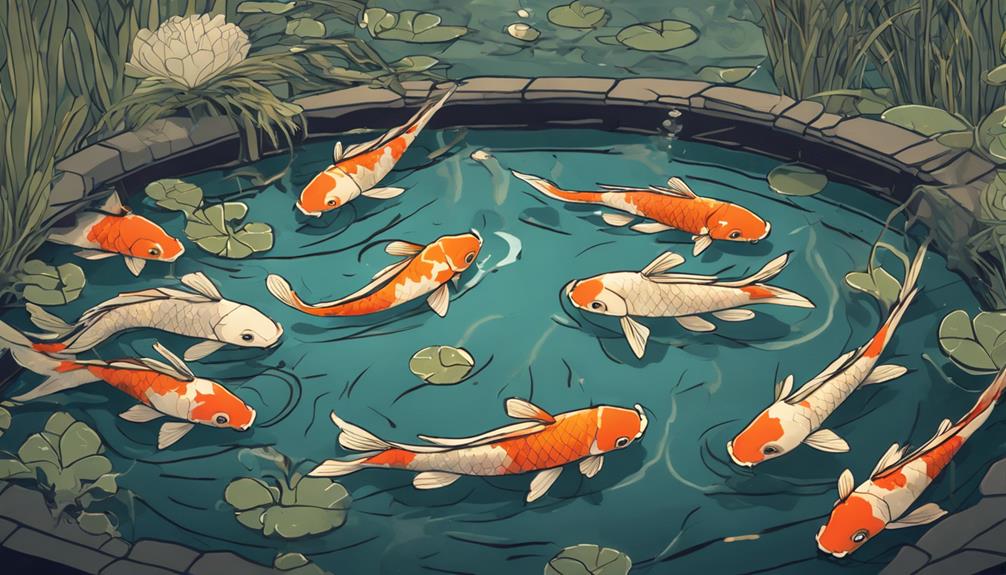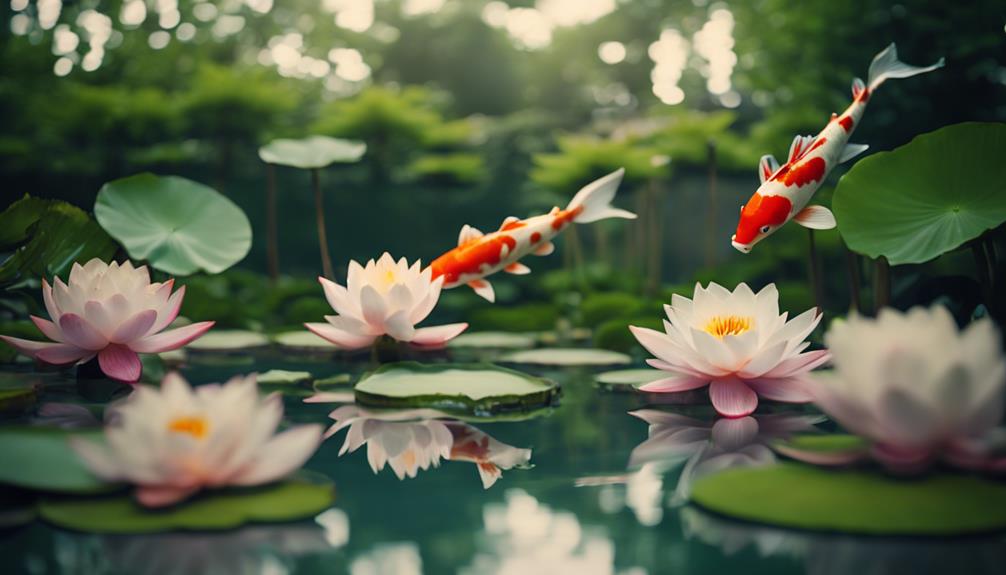When breeding koi, you'll find that simple methods work best. By replicating the natural environment and controlling key factors like water temperature, quality, and chemistry, you create an ideal setup for successful spawning and healthy fry development. You can stimulate spawning by providing a comfortable temperature range and a suitable spawning site. Selecting healthy breeders with desirable traits and providing them with a nutrient-rich diet also increases your chances of success. By focusing on these essential factors, you'll be well on your way to achieving a thriving koi breeding program. Now, discover the specific steps to optimize your breeding process.
Table of Contents
Key Takeaways
- Simple breeding methods allow for precise control over water temperature, quality, and chemistry, leading to a stable environment for koi breeding.
- Selecting high-quality broodstock with desirable traits and characteristics increases the chances of passing on those traits to offspring.
- Implementing simple breeding methods minimizes the risk of disease transmission and genetic defects, resulting in healthier koi.
- Proper care and management of the breeding pond, including regular water changes, maintains top-notch water quality and increases yield.
- Simple breeding methods reduce stress on koi, allowing them to focus on spawning and producing healthy, vibrant offspring.
Preparation and Environment Essentials
Set up a dedicated breeding tank or pond with a capacity of at least 100 gallons to provide a stable environment for your koi.
This will give you better control over water quality, temperature, and other essential factors that influence koi breeding. You'll want to install a spawning rope, which is a key component in the breeding method.
This rope provides a surface for your koi to spawn on, making it easier to collect eggs and prevent them from being eaten by the parents.
Maintain a consistent water temperature between 64°F and 75°F to encourage spawning activity.
Regularly test the water for ammonia, nitrite, and nitrate levels to verify they're within acceptable ranges.
A well-maintained environment will reduce stress on your koi, increasing the chances of successful breeding.
By following these preparation and environment essentials, you'll be well on your way to a successful koi breeding experience.
Understanding Koi Mating and Spawning
As you begin to understand koi mating and spawning, you'll want to appreciate the intricacies of their courtship rituals, which involve specific environmental cues and pheromone signals.
You'll need to prepare a suitable breeding environment that mimics their natural spawning process, where males and females interact in a complex dance.
Koi Courtship Rituals
During the breeding season, you'll observe koi engaging in a complex courtship ritual characterized by specific behaviors that signal their readiness to mate and spawn.
This intricate process is vital for successful breeding, and understanding it can help you optimize your breeding program.
Males will begin to display vibrant colors and patterns to attract females and establish dominance.
Females will start to release pheromones, signaling their readiness to spawn.
A dominant male will pair with a receptive female, and they'll swim together, often in a circular motion.
The pair will select a suitable spawning site, such as a submerged plant or spawning media, where the female will release her eggs.
Breeding Environment Preparation
You'll need to prepare a suitable breeding environment by optimizing your pond's conditions to facilitate successful koi mating and spawning.
Ideally, breed koi between February to May when water reaches 68°F and koi emerge from winter hibernation. Verify your koi pond is clean by using a specialized biofiltration system, and switch off filters during spawning to prevent disruption.
Remove predators and trash from the pond using a skimmer net or comparable scoop equipment, and cover the pond with netting to safeguard koi from cats, birds, and other predators.
Additionally, remove males from the pond if not breeding, as they can stress out females and eat eggs. Use a filtering system to keep the water pure and clear during mating season. This will help increase the chances of successful breeding.
Natural Spawning Process
Koi mating and spawning occur naturally in a prepared breeding environment, where males will pursue females and encourage them to release their eggs. As you observe this process, you'll notice the female becomes more sluggish, indicating she's ready to lay her eggs. During natural spawning, the male koi will fertilize the eggs as they're released, resulting in thousands of eggs being spawned.
Some key factors during the natural spawning process:
Water Quality: Verify the water is clean, clear, and free of toxins to promote healthy spawning.
Water Temperature: Maintain a consistent temperature between 64°F and 75°F (18°C and 24°C) for ideal spawning conditions.
Spawning Substrate: Provide a suitable spawning medium, such as a spawning mat or vegetation, for the eggs to adhere to.
Monitoring: Observe the spawning process closely to confirm the eggs are being fertilized and to remove any unfertilized eggs to prevent fungal growth.
Selecting and Caring for Breeders

When selecting koi for breeding, you'll want to focus on choosing individuals that exhibit desirable traits, such as healthy scales, vibrant color, and well-formed fins.
This is crucial to choose koi that are at least three years old, as they've reached sexual maturity and can produce healthy offspring.
Koi Breeder Selection
Selecting breeder koi that exhibit desirable traits and are properly conditioned is crucial for producing high-quality offspring. As a koi breeder, you want to guarantee that your chosen breeders possess the characteristics you desire to pass on to their offspring.
Some key factors to ponder when selecting your breeder koi:
- Age: Choose koi that are at least 3 years old, as they're sexually mature and can produce healthy offspring.
- Desirable traits: Select a minimum of 1 male and 1 female koi that exhibit healthy scales, fin shape, and color, verifying they've desirable characteristics to pass on to their offspring.
- Health: Avoid breeding koi with injuries, as they may sustain further damage during breeding.
- Conditioning: Feed your koi four times a day with a focus on protein-rich foods to support their bodies during breeding.
Breeding Age Importance
At the heart of successful koi breeding lies the importance of breeder age, a vital factor that substantially impacts the quality of offspring.
You must guarantee that your koi breeders have reached the prime breeding age to produce high-quality eggs and sperm. Japanese koi experts recommend that koi must be at least 3 years old for breeding, as they're sexually mature and can produce healthy offspring.
However, the peak breeding age for koi is between 2-4 years old, when they've reached physical maturity. During this period, female koi are visibly rounder than male koi, especially when ready to lay eggs, making it easier to identify potential breeders.
By isolating prospective parents in separate ponds to condition them for spawning at least 1 month before the anticipated breeding date, you'll set yourself up for successful breeding.
Healthy Koi Characteristics
You'll need to identify healthy koi breeders that possess desirable characteristics to produce high-quality offspring, and this process begins with a thorough examination of their physical traits. When selecting breeders, look for koi that are at least 3 years old, as they're sexually mature and can produce healthy offspring.
Healthy scales are essential for protecting the koi's body, and they should be free from damage or disease.
A well-proportioned body with a balanced shape is a desirable trait in koi breeders.
Bright, vibrant colors are a sign of a healthy koi breeder.
A well-formed fin is important for the koi's overall health and can be passed on to their offspring.
Creating Ideal Breeding Conditions
To optimize koi breeding, breeders must carefully control and manipulate the aquatic environment to create ideal breeding conditions that mimic the natural spawning triggers of these fish.
You'll want to provide a comfortable temperature range between 18-22 degrees C, which induces spawning. Installing spawning ropes or brushes can stimulate the fish to spawn, as they mimic the vegetation found in their natural habitats.
Once spawning occurs, you'll be rewarded with a batch of baby koi, also known as koi fry. To increase their chances of survival, offer live food such as brine shrimp or infusoria, which provide essential nutrients for growth and development.
Maintaining key water quality is essential during this stage, as it directly impacts the health and vitality of your koi fry. By replicating the natural environment and providing the necessary nutrients, you'll be well on your way to successfully breeding healthy koi.
Nurturing Eggs and Young Koi

Once the spawning process is complete, focus shifts to nurturing the delicate eggs and vulnerable young koi, which requires meticulous attention to their specific needs.
As a koi keeper, you play a vital role in guaranteeing the eggs and fry receive the ideal conditions for growth and development.
To achieve this, consider the following essential steps:
Maintain pristine water quality: Monitor water parameters closely to prevent any sudden changes that could harm the eggs and fry.
Provide adequate aeration: Guarantee sufficient oxygen levels to support the developing fry's high energy demands.
Regulate water temperature: Keep the water temperature consistent between 22°C to 25°C (72°F to 77°F) to promote healthy growth and development.
Minimize water flow: Reduce water flow to prevent the newly hatched fry from being swept away or exhausted.
Feeding and Raising Healthy Fry
During the critical first few weeks of life, koi fry require a diet rich in protein to support their rapid growth and development.
You'll want to provide them with live foods like brine shrimp or water fleas, which are packed with nutrients. Feeding your fry 5-6 times a day with Artemia or other live foods can notably increase their survival rate and promote healthy growth.
Around 10 days after hatching, you can introduce artificial foods like commercial baby koi meal kits, but use them in moderation to avoid water quality issues.
Remember, overfeeding can lead to water pollution, so monitoring water quality and adjusting feeding amounts accordingly is vital. Aim for zero ammonia levels in the water.
When feeding, mimic the fry's natural behavior by releasing food at the water's surface using a pipette, encouraging them to swim up to eat.
Breeding Risks and Challenges

As you successfully raise your koi fry, you'll inevitably encounter breeding risks and challenges that can impact the health and survival of your fish, and being aware of these potential pitfalls is key to mitigating their effects.
When trying to breed koi, you're not only dealing with thousands of fry, but also with the risk of disease outbreaks. One major concern is the Herpes Virus, which can decimate your entire stock. Other breeding risks include water quality issues, inadequate nutrition, and genetic defects.
To reduce the number of challenges you face, being fully informed is crucial.
- Disease prevention: Implement strict quarantine and sanitation protocols to minimize the risk of disease transmission.
- Water quality control: Regularly monitor and maintain ideal water parameters to prevent stress and disease.
- Nutritional management: Provide a balanced diet that meets the nutritional needs of your koi at different stages of development.
- Selective breeding: Implement a breeding program that focuses on selecting healthy, disease-resistant individuals to reduce the risk of genetic defects.
Achieving Success With Simple Methods
By adopting simple breeding methods, you can create an ideal environment that fosters successful spawning and healthy fry development in koi.
With a well-planned and executed breeding process, you can increase the chances of getting a higher yield of quality koi, with some breeders reporting up to 50% of eggs hatching and surviving to adulthood.
To achieve success, key is to control water temperature, quality, and chemistry in your breeding pond. This creates a perfect environment for koi to spawn and for fry to develop.
Selecting high-quality broodstock with desirable traits and characteristics is also pivotal, as these traits are more likely to be passed on to the offspring.
Proper care and management of the breeding pond, including regular water changes and maintenance of top-notch water quality, are also imperative.
Frequently Asked Questions
How Do You Breed a Koi Successfully?
You'll successfully breed koi by ensuring ideal water quality, understanding breeding cycles, and preparing a suitable tank with spawning triggers, while making informed genetic selections to produce high-quality offspring.
Are Koi Fish Easy to Breed?
"When you're in the know, breeding koi isn't a piece of cake, but with dedication, you'll find it's not rocket science either. Koi enthusiasts face breeding challenges, especially with diverse fish varieties and intricate color patterns, which are highly sensitive to water quality."
Are Koi Fish Selective Breeding?
You're likely wondering if koi fish are capable of selective breeding, leveraging genetic diversity through natural selection, species adaptation, and evolutionary history to make informed mate choices, ultimately refining desired traits in their offspring.
What Do Japanese Koi Breeders Feed Their Koi?
You'll find Japanese koi breeders serving up a nutrient-rich buffet, juxtaposing traditional live foods like brine shrimp and daphnia with high-quality commercial pellets, optimized for koi growth rates and nutrition facts, mirroring natural food sources.
Conclusion
As you close the lid on your breeding tank, you've set the stage for a dramatic underwater dance.
The fate of your koi's genetic legacy hangs in the balance, suspended like the delicate eggs that will soon hatch.
Will your careful preparation and attention to detail yield a new generation of vibrant, thriving koi?
The wait is agonizing, but the reward could be a school of shimmering, one-of-a-kind beauties that will leave onlookers breathless.

